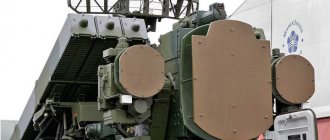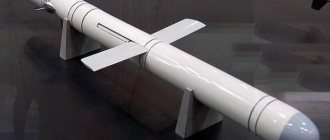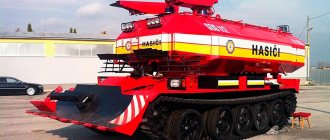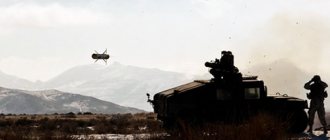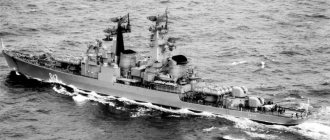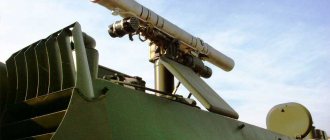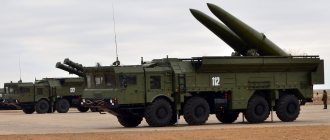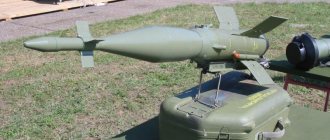On October 7, 2015, from the Caspian Sea, Russian Navy ships launched a missile attack on the terrorist bases of the Islamic State (an organization banned in Russia) located in Syria. 26 Kalibr-NK sea-based cruise missiles were launched. The targets were more than 1,500 kilometers away. By the way, it was on this day that Russian President V. Putin celebrated his 63rd birthday.
The launch of Russian missiles caused a real flurry of controversy. The event turned out to be too extraordinary. The Russian media splashed this news on the front pages, the patriotic public was delighted, and foreign commentators were perplexed. The next day, Pentagon officials said that not all the missiles reached their targets: at least four of them fell on Iranian territory. This claim was later confirmed by several other sources.
The Russian Ministry of Defense angrily denied this information, assuring that all the missiles reached their targets and successfully hit them. The Americans later stated that they had not received any warning regarding the use of such weapons and called the actions of the Russian military “unprofessional and threatening.”
It is clear that the use of such weapons had not so much a military as a political purpose. Shooting very expensive missiles at guerrilla terrorist groups is not a very rational idea. The same result could have been achieved by using a squadron of Su-25 attack aircraft. But Moscow showed its “Western partners” that it has weapons that are not inferior in their characteristics to the famous Tomahawks.
Is it so? Has the Russian army really acquired cruise missiles with a strategic range? What is the Kalibr missile system, what technical characteristics does it have? Let's try to figure this out.
Cruise missiles: history of development
The idea of creating an unmanned aerial vehicle, stuffing it with explosives and sending it to the adversary’s head appeared quite a long time ago, almost at the dawn of aviation. Work on them began immediately after the end of the First World War, but due to the imperfection of technology at that time, it was not successful.
The first production cruise missile was the German V-1; at that time, such devices were usually called “projectile aircraft.” The Germans made the furthest progress towards creating such weapons, and after the end of the war, many of their developments fell into the hands of the victors.
The development of cruise missiles began in both the Soviet Union and the United States. With the advent of nuclear weapons, the topic became especially relevant. But in the USSR this work was somewhat relegated to the background; the Soviet leadership made its main bet on ballistic missiles. At the same time, back in 1959, under the leadership of designer Chelomey, the P-5 cruise missile was created, capable of flying 500 km and carrying a warhead of 500 kilograms. True, it was developed for submarines.
The next sea-launched cruise missile in the USSR was developed for almost fifteen years. Work on the Granit missile began in 1969 and was completed only in 1983. The Granit was also a sea-based anti-ship cruise missile, its main function was to destroy the aircraft carriers of a potential enemy. It had a reach radius of up to 600 kilometers.
The Americans at that time were developing a rocket, which later became a real legend. We are talking about Tomahawk. By the end of the 70s of the last century, the new navigation and course correction system TERCOM (Terrain Contour Matching) was significantly improved; it was this system that was installed on the first modifications of this missile and determined its effectiveness.
This system scanned the folds of the terrain using its equipment and compared them with a digital map stored in its memory, which allowed the Tomahawk to fly at low altitudes, skirting the terrain. This gave two undeniable advantages at once: flying at low altitude made detecting this missile by air defense systems a difficult task, in addition, such a navigation system was very reliable and autonomous. True, this system did not work over the water surface and required maps of each combat area.
Around the same years, the USSR developed the S-10 Granat sea-based missile system with a cruise missile range of up to 2.5 thousand kilometers. At the same time, the Tomahawk modification appeared, equipped with a new DSMAC navigation and course correction system.
Digital photographs of the terrain were stored in the memory of this rocket; the rocket simply compared them with the surrounding terrain. This made it possible to increase the accuracy of the Tomahawk to values unimaginable at that time (the probable circular deviation did not exceed 10 meters). It was from this time that the triumphant takeoff of Tomahawk began. It could now be used as a high-precision, powerful, but conventional weapon with a huge damage radius. The range made it possible to accurately hit targets deep in enemy territory with the Tomahawk.
Since then, Tomahawks have been constantly modernized. The last upgrade took place in 2004, it significantly reduced the cost and somewhat simplified the rocket, but at the same time it was equipped with more advanced navigation equipment, which increased its range. Currently, a new, even more advanced modification of the Tomahawk is being developed in the United States.
In 1983, OKB Novator began work on creating a new anti-ship cruise missile (OKR Biryuza) to participate in a competition announced by the USSR Ministry of Defense. The design bureau won this competition, and the rocket was first shown to the general public in 1993. It was on its basis that the 3M54 anti-ship missile was later created, which became the basis for the Caliber missile system and the ancestor of a whole family of missile weapons. This also includes the 3M14 strategic cruise missile, which has a damage radius of up to 3 thousand kilometers. This weapon can easily be called strategic.
Based on the 3M54 "Caliber" missiles, several missile systems were created, which are installed on various carriers:
- Club-N, Club-U: missile systems that are installed on surface ships (NS);
- Club-S: complexes that are installed on submarines, they are launched from torpedo tubes;
- Club-M: missile systems for mobile coastal systems;
- Club-K: a complex installed in ordinary transport containers.
There is also "Caliber", created for the air force.
All missiles can be divided into three large groups: anti-ship, against ground targets and against enemy submarines. Not all information is available on these weapon systems - the technical characteristics of the systems entering service with the Russian army are classified. Neither their flight range, nor speed, nor the radius of possible deviation from the target are known. Only technical characteristics of export models of Caliber missiles are available in the public press.
In 2012, the ship of the Caspian flotilla “Dagestan” was launched. It became the first in the Russian Navy armed with the Caliber-NK missile system. "Dagestan" has already conducted training firing from "Caliber-NK", and the missiles successfully hit a training target on the shore. The Kalibr-NK complex is armed with the 3M14 missile, which is capable of hitting sea targets at a distance of 360 kilometers, and ground targets at a distance of 2,600 kilometers. Similar weapons began to enter service with several classes of warships of the Russian Navy. For example, the Caliber-NK complex was armed with Project 21631 missile launchers.
Caliber's firm tread
It should be noted that the export version of the rocket became the test bench on which domestic designers, in conjunction with the military, worked out all possible and promising options for the development of this model. If for delivery abroad the cruise missile was equipped as a SLCM (sea-launched cruise missile), then for equipping our own armed forces all basing options were considered. For example, the submarines of the Chinese, Algerian and Indian navies of Project 636.6 are equipped with Club cruise missiles, the range of which does not exceed 300 km. This limitation is explained by the Agreement on the Control of the Non-Proliferation of Missile Technologies, to which the Russian Federation is a signatory.
Club
The Chinese have already rushed to create their YJ-18 cruise missile, which, in terms of its main tactical and technical characteristics and parameters, is rather a copied Russian “Caliber”.
If we take into account the entire Caliber missile system, it is in its own way a unique combat system. For each type of armed forces that are equipped with Russian cruise missiles, there is its own version, which has its own characteristics and distinctive characteristics. All modifications are united by two important components - high accuracy and enormous flight speed. At a flight speed greater than the speed of sound, the missile is capable of hitting a target the size of a beach umbrella at a distance of over 300 km. The ground and sea variants for basing cruise missiles are considered basic. Unlike the naval version, aircraft missile systems do not have solid fuel boosters.
The naval version of the Kalibr-NK is equipped with boosters that accelerate the missile to a speed of Mach 2.5-3. Is it worth comparing the Russian modification with the American Tomahawks, which fly at sound speed and can even be shot down by conventional aircraft?
In all other respects, the missiles of all modifications are quite similar, both in the main structural elements and in the flight control system. They are based on an inertial orientation system in space. The flight is carried out in autonomous mode and only on the final trajectory the radar target designation and guidance heads are included in the missile control. The complex is equipped with a space signal receiver, so the GLONASS global space communications system can be used to control military weapons.
Flight of Caliber
The naval version of the cruise missile has performance characteristics that are designed to effectively combat naval targets, including aircraft carriers, cruisers and destroyers. Moreover, the missile’s flight is carried out under conditions of severe electronic countermeasures from the enemy. The combat content of the "Calibers" makes it possible to inflict serious damage even on such giants as the Nimitz-class nuclear-powered aircraft carriers are today. The ability of the Russian missile to overcome a fairly developed enemy air defense system was an unpleasant surprise for the Americans, who, having Tomahawks, clearly cannot boast of this.
The launched cruise missile follows a given route in complete radio silence. Only at the final stage of the flight does the navigation system, built on an algorithm of 15 control points, come into effect. “Caliber” is impossible to predict, since a missile can appear in front of the target in any direction.
Hitting the target
Description of the 3M54E and 3M541E missiles
The cruise missiles in service with the Kalibr complex can be examined using the characteristics of the 3M-54E and 3M-54E anti-ship missiles as an example.
These sea-launched cruise missiles are designed to arm submarines and are designed to destroy enemy ships.
Both missiles have a normal aerodynamic design and are as unified as possible.
The span of the trapezoidal drop-down wing is 3.1 meters. The 3M-54E anti-ship missile has three stages: launch, sustainment and combat. The 3M-54E1 missile is equipped with two stages; it does not have a combat stage. Due to this, its flight range is increased.
The launch stage ensures the launch of the anti-ship missile and its acceleration; lattice stabilizers are located in the rear part of the rocket; the launch stage is equipped with a solid propellant engine.
Then the main engine is turned on, which operates for most of the rocket’s flight (for the 3M-541M, the entire flight), providing transonic speed. The main stage contains the turbojet engine TRDD-50B. In this section of the trajectory, the rocket flies at an altitude of 15-20 meters.
At a distance of 30-40 km from the object, the target is captured by the missile guidance head. 3M-54E makes a slide, the second stage is separated. The first stage solid propellant engine is turned on, which accelerates it to a speed of approximately 1000 km/h. The two-stage 3M-54E1 performs a special anti-missile maneuver before approaching the target.
Both modifications of the missile are equipped with an inertial navigation system and a radar homing head. The warhead of the 3M-54E is 200 kg, and the 3M-54E1 is 400 kg. The warhead penetrates with detonation at the required depth, it ensures reliable destruction of the target. The flight range of the 3M-54E is 220 kilometers, and the range of the 3M-54E1 is 300 km.
Demonstration performances of the Russian Caliber
For the first time, the power and technical achievements of the Russian defense industry were demonstrated to the world on October 7, 2015. From the Caspian Sea, 26 cruise missile launches were carried out from 4 ships of the Caspian Military Flotilla against targets located in Syria. The low-altitude missiles covered a distance of 1,500 km, crossing the airspace of Iran and Iraq. The achieved result was consolidated by the following launches. Already on November 20, sea-based cruise missiles “Caliber NK” were launched again from the Caspian region, launched from warships of the Russian Navy.
Launching Caliber from ships
Two weeks later, similar launches took place from the Mediterranean Sea and from another carrier. The launch site this time was the Project 636.3 Varshavyanka submarine of the Black Sea Fleet Rostov-on-Don. The missiles hit various targets in the Syrian provinces of Raqqa and Itlib, causing significant damage to ISIS militants. Since the first combat launches, Russian cruise missiles have shattered the monopoly of Western countries on the use of this type of weapons. From that moment on, the balance of power changed radically. Russia has demonstrated to the whole world that it now has the necessary weapons capable of hitting potential enemy targets not only near its own territory, but also at a considerable distance.
It should be noted that Russia, unlike the Americans, did not use large naval combat units to launch Caliber. From now on, small missile ships equipped with similar weapons will come to the fore. Russian small missile ships, essentially similar to 19th-century gunboats, can deliver a devastating blow to any target. From this moment on, neither the ship’s displacement nor the power of its air defense systems play any role. Thanks to Caliber, the Russian Navy got its hands on a precision instrument capable of reaching the enemy at a great distance with surgical precision.
Missile strike diagram
Description of the 3M-14E rocket
3M-14E missiles are used to destroy ground and surface targets. This missile can hit not only enemy ships, but also objects located on land: control centers, airfields, warehouses, infrastructure facilities. It also has a normal aerodynamic configuration; its trapezoidal wings open after the propulsion engine starts.
3M-14E has two stages: launch and sustainer. The launch stage ensures the launch of the rocket and its acceleration. It is equipped with a solid fuel engine. Then the air intakes are opened, and the sustainer stage turbojet engine is turned on, which ensures the flight of the rocket along the main part of its trajectory. In this area it develops transonic speed. Flight range – 300 km.
The guidance system is a combined one, it consists of an inertial navigation system, radar-based navigation system, and also uses correction using signals from GLONASS or GPS satellites.
The weight of the warhead is 450 kilograms. There is an air blast option. Over the sea the flight occurs at an altitude of 20 meters, over land - 50-150 meters. The missile can bypass areas with difficult terrain or areas too saturated with enemy air defense systems. To do this, special turning points are included in its flight mission.
Technical characteristics of the Caliber missiles
We do not have comprehensive information about these missiles. Minimal data is available on modifications intended for export, but most of the characteristics of the sea-based Kalibr-NK complex are classified. Here are the performance characteristics that we know:
| Rocket | 3M-54E | 3M-54E1 | 3M-14E | 91RE1 | 91RTE2 |
| Length | 8.22 m | 6.20 m | 6.20 m | 7.65 m | 6.20 m |
| Diameter | 533 mm | 533 mm | 533 mm | 533 mm | 533 mm |
| Launch weight | 2300 kg | 1800 kg | 1770 kg | 2100 kg | 1200 kg |
| Warhead | Penetrating high explosive 200 kg | Penetrating high explosive 400 kg | High-explosive fragmentation or cassette 450 kg | APR-3ME torpedo | Torpedo MPT-1UME |
| Range of flight | 220 km | 300 km | 300km | 50 km | 40 km |
| Airspeed | On the march: M=0.8 At the target: M=2.9 | M=0.8 | M=0.8 | M=2.5 | M=2.0 |
| Trajectory | On the march: 20 m At the target: 10 m | 20 m | Above sea: 20 m Above land: 50-150 m | Ballistic | Ballistic |
| Control system | INS + RLGSN | INS + RLGSN | INS + RLGSN + correction according to GLONASS or GPS data | ANN | ANN |
b ZHEKYU SMKHTHYUZHKH YAKHYAREL BNNPSFEMKH PUYERYU 3l54sch YANGDUERYA EYUREPHMASPTSYAYHL lya "mNBYURNP" YUY SMKHBEPIYUKEMYU. pYUGPYUANRYUMN YELEIYARBN SOYUBKELSHU PUYER “YUKHAP”, ONKSVKHBHE SHYYAONPRMNE MYUGBYUMHE “Club”.
nMH OPEDMYUGMYUVEMSH DK PUGLEYEMH MU ANEBSHU MYUDBNDMSHU YNPYUAKU, ONDBNDMSHU KNDYUU X SDYUPMSHU YYULNK╦RYUU. b NYAMNBS PYUGPYUANRYKH ASHKYU ONKNFEMYU YARPURETSKHVEYAYU YPSHKYURYU PYYERYU "tsPYUMYUR" (YND murn SS-N-21 Sampson), YNRNPNI BNNPSFYUKHYAE YURNLMSHE ONDBNDMSHE KNDYH OPNEIRYU 971 , 945, 671 prl, 667 yur X DP.
PUYERSH YUBHYUZHNMMNTSN BYUPHYUMRYU YNLOKEYAYU - “YUKHAP-yu”
OPEDMYUGMYUVEMSH DK ONPUFEMKH B OPNYARSHU X YAKNFMSHU LERENSYAKNBKHU DMEL X MNVECH YARYUZHNMYUPMSHU X LYUKNONDBHFMSHU MYUGELMSHU (AEPETSNBSHU) X LNPYAIKHU ZHEKEY:
- lNDHTHYUZHH 3l-54yushch —
OPNRKHBNYNPYUAEKEMYU RPEUYARSOEMVYURYU YPSHKYURYU PUYERYU I NRDEKELNI YABEPUGBSYNBNI ANEBNI YARSOEMCH.
- lNDHTHYUZHH 3l-54yushch-1
- OPNRKHBNNYNPYUAEKEMYU DBSUYARSOEMVYURYU DNGBSYNBUYU YPSHKYURYU PUYERYU.
- lNDHTHYUZHH 3l-14yush
— DNGBSYNBU YPSHKURYU PYYERYU DK ONPUFEHMKH MUGELMSHU ZHEKEY.
BOEPBSHE B ONKMNL YANYARYUBE YAELEEYARBN joint venture "YUKHAP/Club" ASHKN OPEDYARYUBKEMN B UNDE BSHYARYUBYKH IDEX-2007, OPNYEDYEI B YuAS-DYUAKH (nyush). REOOPE YAHYARELYU "Club" OPEDYARYUBKEMY B VERSHPEU BYUPHYUMRYU PYUGLEYEMH:
- KHMRETSPHPNBUMMMYU PUYERMYU YAHYARELYU "Club-S
» (yYUKHAP-oksh) DK BNNPSFEMH ONDBNDMSHU KNDNY I PUYERYULH DK ONPUFEMKH MYUDBNDSHU, ONDBNDMSHU KH MUGELMSHU ZHEKEY;
- KHMRETSPHPNBUMMMYU PUYERMYU YAHYARELYU "Club-N
» (yYUKHAP-myshch) DK BNNPSFEMKH MYUDBNDSHU YNPYUAKEI I PUYERYULH DK ONPUFEHMKH MYUBNDMSHU, ONDBNDMSHU H MYUGELMSHU ZHEKEY;
- AEPETSNBNI YNLOKEYA PUYERMNTSN NPSFKH (ipn) «Club-M
» I PUYERYULH DK ONPUFEMKH MYUDBNDMSHU X MYUGELMSHU ZHEKEY (3l-54ysch, 3l-54ysch1 X 3l-14yshch);
- YPSHKYURSHE PUYERSH YUBKHYUZHNMMNTSN AYUGHPNBYUMKH "Club-A
» (yUKHAP-yu) DK ONPYUFEHMKH MYUDBNDMSHU X MYUGELMSHU ZHEKEY (3l-14yushch, 3l-54yushch X 3l-54yushch1).
BYAE PUYERSH SMKHTKHZHPNBUMMSH ON ANKEHMYARBS SGKNB, MN EYARE KH PUGKHVKH. b NRKHVHE NR AYUGNBSHU BYUPKHYUMRNB LNPYAYNTsN X MUGELMNTSN AYUGHPNBYUMH, PUYERSH YUBKHYUZHNMMNTsN AYUGHPNBYUMKH ME ASDSR NANPSDNBYUREYYARYUPRNBSHLH RB╦PDNRNOKHBMSHL X DBHTSUREKLH. b YUVEYARBE LYUPYEBSHU DBKHTSYUREKEY NYARYUMSRYA DNPUANRYUMMSHE OND SYAKNBKH SHYAOXYURYUZHH RPDD, OPNKHGBNDYARBU nyun “mon “YURSPM””, ONYARYUBKELSH DK BYAEU BYUPHYUMRN B PUYER. ANPRNBNI YNLOKEYA SOPYUBKEMKH BYAU PUYER ONYARPNEM MU AYUGE YUBRNMNLMNI KHMEPZHHYUKEMNI MYUBKHTSYUZHNMMNI YAKHYARELSH UA-40SH (PYUGPYUANRVKHY - TSNYASDYUPYARBEMMSHY mxx oPKHANPNYAR PNEMHЪ). mYUBEDEMKHE MU YNMEVMNL SVIYARYE RPYUEIRNPKHH NYASYYARBKERYA OPH ONLNYH ONLEUNGYYYHYEMMSHU YYRKHBMSHU PUDHNKNYUZHNMMSHU TSNKNBNY YAYULNMYUBEDEMKH, YANGDYUBYUELSHU B nyun "pYUDYUP-lla." b YANYARYUB YNLOKEYAYU SOPYUBKEMKH PUYER BUNDHR PYUDKHNBSHYANRNLEP RHOYU pbshch-a, Yu MU 3l-14yushch DNONKMHREKEMN SYARYUMNBKEM OPHELMKHY YAHTSMYUKNB YNYALKHVEYAYNI MYUBKHTSYUZHNMMNI YA KHYARELSH. BYAE PUYERSH NYAMYYEMSH TSTSYUYAMSHLH av, I YNMRURYRSHL H MEINMRURMSHL bs.
PUYERSH 3l-54yushch
X
3l-54yusch-1
NAEYAOEVHBUCHR ONPUFEMHE MYUDBNDMSHU NDHMNVMSHU X TsPSOOONBSHU ZHEKEY (RHOYU YPEIYAEP, SHYALKHMEZH, DEYUMRMSHI YNPYUAKE, RPYUMYAONPR, LYUKSHI PUYERMSHI YNPYUAKE) B SYA KNBKHU PYUDKHNSCHKEYRPNMMNTsN OPNRKHBNDEIYARBKH. PUYERSH NYAMYUYEMSH ANEBNI VYUYARECH I ONDPSHBNL MU NORKHLYUKEMNI TSKSAKHME OPNMKHYMNBEMKH. aNEBNE HYAONKEGNBUMHE PUYER NAEYAOEVKHBUERYA B KCHANL PUINME lHPNBNTSN NYYUMYU B KCHANE BPEL YASRNY X TSNDYU, OPYURKHVEYAYKH B KCHASHU LERENSYAKNBHYU. ONK╦R XU OPNUNDHR ON GYUPUMEE GYUKNFEMMNLS LYUPPSRS (OPEDBYUPHREKEMYU ONDTSNRNBYU ONKERMNTSN GYUDYUMKH), B YANNRBERYARBHH I DUMMSHLH PUGBEDYKH NRMNYAHREKEMN ONKNFEMKH ZHEKH X MYUKHVKH YAPEDYARB OPNRKHBNBNGDSSMNI NANPNMSH. PUYERSH YAONYANAMSH OPENDNKEBURE GNMSH PUGBHRNI YAKHYARELSH obn OPNRKHBMKHYU, VRN NAEYAOEVKHBUERYAJ OPEDEKEMN LYUKSHLH BSHIANRYULH ONKERYU X YUBRNMNLMNYARECH MYUBEDEMKH B PEFHLE "LNKVYUM" XЪ" MY NAMNBMNL SVYARJE. mYUBKHTSYUZHKH PUYER OPNKHGBNDKHRYA ON YAKNFMNI RPYUEIRNPKHKH, I HYAONKEGNBYUMHEL DN 15 GYUDYUMMSHU NONPMSHU RNVEY, NMYU LNFER ONDUNDKHRE Y ZHEKKH I GYUDYUMMNTSN MYOPYUBKEMKH, B NAU ND NYARPNBNB X obn. dKЪ PUYERSH 3l54sch B ya "pYUDYUP-lla" (TSEMEPYUKEMSHI DKHPEYRNP c.b. YuMZHEB, TsK. YNMYARPSYRNP ts.yu. YANKNBEEB) YYULNMYUBEDEMKH (yuptsyam), YNRNPYU B 2000 Ts. yuptsya-54 HLEER LYYYAHLYUKEMSCH DUKEMNYARE NYNKN 60YL. dKKHMYU yuptsa-54 - 70YAL, DHYULERP - 42YAL X BEYA - 40YTS. nMYU NAKYUDYUER BSHIANYNI ONLEUNGYYYYYYEMNYARECH KH LNFER TSMYZHNMHPNBURE OPH BNKMEMHKH LNPJ DN 5-6 AYUKKNB.
oPNRHBNNYNPYUAEKEMYU PUYERYU 3l54sch YANYARNHR HG YARYUPRNBNI YARSOEMH, YPSHKYURNI DNGBSYNBNI MKHGYNKERYYE LYUPYEBNI YARSOEMKH X MKHGYNKERYYE YABEPUGBSYNBNI ANEBNY YARSOEMKH I pdrr . oEPBYU YARYUPRNBYU YARSOEME NAEYAOEVHBUER BSHUND HG OSYAYNBNTSN SYARPNIYARBU H PYUGTSNM PUYERSH. GYUREL OEPBU YARSOEME NRDEKERYA, GUOSAYYUERYA LUPEBSHI DBKHTSYUREKE, PYYAYPSHBUERYA YPSHKN H NOEPEMKHE, PYYERYU YAMKHFUERYA DN 10-15 L H KERHR Y ZHEKH ON DUMMSHL ANPR NBNI KHMEPZHYUKEMNI YAKHYARELSH SOYUBKEMKH. bRNPUYU - LYUPYEBUYU - BSHONKMER ONKER MU NYAMNBMNL SVYUYARYE RPYUEIRNPKHH, BSHBNDHR PUYERS B PUINM ZHEKH X OPNKHGBNDHR ONKHYAY X GUUBYUR ZHEKH TSNKNBYNI YAYULNMYUBEDEMKH (cyam), ONYAK E VETSN NRDEKERYA ANEBYU YARSOEME - RPERE. nMU YAKSFHR DK OPENDNKEMKH MU YABEPUGBSYNBNI YAYNPNYARKH YAHYARELSH obn OPNRKHBMKHYU. MU YUBHYUZHNMMNL BYUPKHUMRE OPNRKHBNNYNPYUAEKEMNI PUYERSH 3L-54sch YARYUPRNBUJ YARSOEME NRYASRYARBSER, LYUPYEBU - NAEYAOEVKHBUER ONKER MU NYAMNBMNL SVYUYARYE RPYUEYRNPHHH, BRNPYU Kommersant - ANEBYU - YAKSFHR DK OPENDNKEMKH MU YABEPUGBSYNBNI YAYNPNYARKH 3l YAKHYARELSH obn OPNRKHBMKHYU.
YARYUPRNBYU YARSOEME NAEYAOEVKHBUER YARYUPR KH PUGTSNM PUYERSH, YAMYUAFEMYU RBEPDNRNOKHBMSHL NDMNYYULEPMSHL PUYERMSHL DBKHTSUREKEL, YUMYUKNTSKHVMSHL DBKHTSUREKCH YPSHKYURNI PUYERSH "tsPYUM" YUR." BrNPYU YARSOEME - LYUPYEBU - NAYEOEVHBUER ONKER MU NYAMNBMNL SVYYARYE RPYUEIRNPKHH I NYNKNGBSYNBNI YAYNPNYARECH. dBKHTSYUREKE BRNPNI YARSOEMKH - RSPANPEYURKHBMSHHI rpdd p95-300(pd-300), PYUGPYUANRYUM B ya "YANCHG".
mu AYUGE PUYERSH 3l-54 B nya "mNBYURNP" YANGDYUM DBSUYARSOEMVYURSHI BYUPHYUMR 3l-54yushch-1
. OPH PEYEMHH GYUDYUV MU LNPE, OPNRKHBNYNPYUAEKEMYU PUYERYU 3l-54yushch1 KHLEER LEMEKHE TSYUAYUPHRSH X LYuYAS, B YAPYUBMEMHH I 3l√54yushch, NDMYUYN HLEER ANKESCH ONPUYUFYUCHYCH SCHTT EIRKHBMNYARE AKYUTSNDYUP av SBEKHVEMMNI LYUYAYASH. NDMUYN, OPEHLSYYARBNL 3l√54yushch ЪБКЪРЪЯЪ ЪБКЪРЪЯБПУГБСЪНБУЪ YAYNPNYAREH OPEDEKEMN LYUKYU BSHIANRYU ONK╦RYU MU YNMEVMNL SVYYARYE (ANEBYU YARSOEME NRDEKERYA Kommersant GYU 20YL NR ZHEKKH YURYUSER MU YAYNPNYARKH 700-1000L/Y MU BSHIANRE 10-20L). BOEPBSHE KHMTNPLYUZHKH ON 3L-54YUSCH-1 ASHKYU OPEDYARYUBKEMYU MU BSHYARYUBYE "Khldschya SHYU-99" B YAKHMTSYUOSPE B LYUE 1999 Ts., TsDE "pNYABNNPSFEMKHE" YANBLEYARMN Ya nya "mNBYURNP" OPH YARSOKHKH Y LYUPYERKHMTS MNBNTSN NPSFKH. b RNL FE TSNDS PUYERU 3l54sch1 BOEPBSHE OPNDELNMYARPHPNBUMYU B PNYAYAHH MU BSHYARYUBYE BNNPSFEMKHI B mHFMEL RUTSKHKE.
RHONBSHLH ZHEKLH DK BSHYANINRNVMNI YPSHKYURNI PUYERSH 3l-14yushch
ЪБКЪЧРЯЪ MUGELMSHE OSMYRSH SOPYUBKEMKH BNIYAYULH, YAYKYUDSH BNNPSFEMKHI H RNOXBYU, YUSCHPNDPNLMSHE H ONPRNBSHE YANNPSFEMKH. b YANYARYUB ANPRNBNI YAHYARELSH SOPIUBKEMKH BUNDIR BSHIANRNLEP (RHOYU pbsch-a), NAEYAOEVKHBUCHYKHI YAYPSHRMNYARE ONKERYU MYUD YASYEI GYU YAVER RNVMNTsN BSHDEPPHBYUMKH BSHYANRSH B PEFHLE NC KHAYUMH PEKETYU LEYARMNYARKH, X YAKHYARELYU YAOSRMHYNBNI MYUBKHTSYUZHHH RHOYU tsknmyuyaya XKH GPS, NAKYUDYUCHYYU BSHYANYNI RNVMNYARECH MYUBEDEMKH. b DNONKMEMKHE PUYERYU 3l-14sch NYAMYUYEMYU YURKHBMNI PUDHNKNYUZHHNMMNI TsNKNBYNI YAYULNMYUBEDEMKH yuptsya-14sch, PYUGPYUANRYUMMNI B nyun “moo “pYUDYUP - llya”.
3l-14yushch B ONK╦RMNI YNMTHTSSPYUZHHH
YYY YANNAYYUERYA, PUYERSH OPEDMYUGMYUVEMSH DK BNNPSFEMKH YASYYYARBSCHYKHU H OEPYAOEIRKHBMSHU YUBKHYUZHNMMSHU MNYAHREKEY, ONYARYUBKELSHU MU SHYYAONPR. MUHANKEE BEPNRMSHLKH MNYAHREKLKH LNTsSR ASHRE YAYULNKERSH YAS-35, LHTS-35, YAS-27YSA X DP. b YNMZHE 2006 TSNDYU B PEIKYULMSHU LYUREPHYUKYU YASUNI/yMyuyuon ASHKYU PUYAOPNYARPYUMEMYU HMTNPLYUZHH N RNL, VRN B YUVEYARBE SHKELEMRY BNNPSFEMKH MNBNTsN SDYUPMNTSN YAYULNKERYU YAS-35 al ASDER OPEDKYUTSUREYAY MU SHYYAONPR PUYERU ANKENNY DUKEMNYARH "YUKHAP-yu". ONGFE X pyay "lHts" GYUBHKYU N BNGLNFMNYARH NYAMYUYEMH YAN BPELEMEL YABNETSN MNBNTSN KHYARPEAHREK lHts-35 PUYERYULH 3l-14yushch DK ONPYUFEMHYUGELMSHU ZHEKEY.
Club-K missile system
The characteristics of the missiles used in the Caliber complex not only make it possible to reliably hit ground and sea targets, but they can change the very tactics of using such weapons.
The Club-K missile system was first demonstrated in 2009 at the Asian Arms Exhibition, where it created a real sensation. The point here is this. This complex is the most common transport sea 40-foot container. It contains four 3M-14E, 3M-54E or 3M-54E1 missiles. It is almost impossible to distinguish it from a real cargo container.
A container with missiles can be installed on any truck, railway platform, or ship. Moreover, such a container can be sent to the shores of any country and launch a missile in close proximity to the target. No missile defense system will help in this situation; there simply isn’t enough time.
In fact, Club-K is an ideal weapon for terrorists or countries that cannot compete on equal terms with wealthy powers with money for aviation and Tomahawks.
It is simply impossible to track all the containers that ply the World Ocean; they number in the hundreds of thousands. Such missile systems are invisible to any technical reconnaissance means. Any civilian ship can pose a threat. The oceans have always reliably protected the United States from external enemies. If these weapons fall into the hands of American ill-wishers, then the oceans will turn from a protective line into a threat.
Do not forget that cruise missiles pose a big problem for air defense systems.
The Club-K complex is relatively inexpensive, only $15 million; American experts are most concerned about the fact that Russia is offering these weapons to all countries that may suffer from US policies. Unable to compete with American military power openly, these countries may use Club-K as a weapon of retaliation. To do this, you simply need to bring a container with missiles to the American shores within the distance of a missile salvo.
Pentagon experts have already expressed the opinion that if Saddam Hussein had such weapons in 2003, the invasion of Iraq would hardly have taken place.
At the same time, the West cannot ban the export of such weapons. It is not subject to prohibitions. The destruction range of the Club-K complex is “only” 200-300 km.
The complexes have already been purchased by India and China, and negotiations are underway with several other countries.
Russian cruise missile as an effective element of the concept of nuclear deterrence
The combat use of the Russian Kalibr in the fall-winter of 2015 clearly demonstrated the tactical capabilities of the missile system. However, from the point of view of strategic use, the Russian development becomes an effective weapon, capable of inflicting significant blows on a potential enemy if necessary.
Combat launches of missiles that flew a distance of 1,500 km showed that the Russian Navy from the Baltic and Black Seas can control the Northern Maritime Theater and the Mediterranean basin. A missile equipped with a 10-15 kt nuclear warhead can fly 2-2.5 thousand km. Moreover, its launch can be completely unexpected for a potential enemy, from aboard a conventional diesel submarine.
